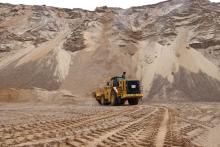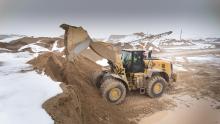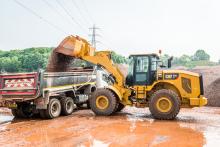Peter-Valentin Sauter has worked for nearly 25 years in the global quarrying and construction equipment business, with the last six years spent as Caterpillar’s quarry industry consultant in Europe, Africa and the Middle East. Guy Woodford spoke to him about his important customer-facing work and prospects for growth in the quarrying industry.
Whether it’s in the height of spring or summer, or in the darker and colder months of the autumn and winter, Peter-Valentin Sauter can always be found on a customer quarry site somewhere in Europe, Africa or the Middle East (EAME). As Caterpillar’s quarry industry consultant for EAME, and, given the increasingly bespoke needs and varying technical knowledge of quarry equipment fleet owners and contractors, the German national is rarely seen at his desk at Caterpillar’s office in Geneva, Switzerland. Such a wealth of quarry face experience also makes him the perfect person to assess the industry’s current and likely future equipment market needs.
[caption id="attachment_86513" align="alignright" width="231"] Peter-Valentin Sauter, Caterpillar's EAME quarry industry consultant, at the famous Carrara marble quarries in Italy earlier this year[/caption]
Peter-Valentin Sauter, Caterpillar's EAME quarry industry consultant, at the famous Carrara marble quarries in Italy earlier this year[/caption]
Given his itinerant role, it’s apt that I’m speaking to Sauter just before he’s about to meet a number of Caterpillar customers in the famous Carrara quarries in northern Tuscany, Italy,??So, what is the current number one priority for the equipment manufacturing giant’s quarry owners and contractors? “Machine uptime is critical. Whether you have one shift or two shifts of production, a quarry is run like a factory. A factory without a roof. If one of your key machines is not working, the whole operation is at a standstill. If you have a cement plant attached to your quarry and you have to stop the mixing oven, it will be even more costly.
“If you have a problem you need it fixed very quickly, and that’s why having access to quality servicing in close proximity to you, via a global equipment dealership network, is so important. In Europe, Caterpillar servicing assistance, for instance, is half-an-hour to one hour max away from all customers.”
Sauter says it’s becoming increasingly important for Cat technicians to undergo regular high quality training. “All our dealers are constantly training our technicians as we have such a variety of equipment, with new technology being installed on models all the time. The technicians have to be very skilled to fix problems. Excellent replacement parts availability is also vital for maintaining customer equipment uptime. Caterpillar can deliver globally around 98% of replacement parts to customers within 24 hours.”
Prior to his current position at Caterpillar, Sauter worked as a servicing support specialist for the company’s German dealership, Zeppelin Cat. Providing high quality fleet servicing for Caterpillar customers in Europe’s biggest national quarrying market, a market known for its widespread use of the latest machine fleet optimisation technology, equipped Sauter with huge knowledge of best working practice.
He highlights how Cat Product Link, through its easy-to-use VisionLink interface, is giving quarry customers and their local Cat dealers, via cell and satellite, customised machine fleet health and utilisation reports.
[caption id="attachment_86512" align="alignleft" width="462"] CAption 2A Cat 352F XE hydraulic excavator loading a Cat rigid dump truck. The 352F XE now comes with a new CPM[/caption]
CAption 2A Cat 352F XE hydraulic excavator loading a Cat rigid dump truck. The 352F XE now comes with a new CPM[/caption]
“It’s a big asset. Product Link is fitted as standard on all Cat quarry machines of 15 tonnes and above. Fault codes are automatically generated if there are any problems, so dealers can act immediately to resolve them. This maximises machine uptime, thus reducing your operating cost per tonne; that’s the ultimate performance measurement for any quarry.”
While employing more skilled machine operators and limiting the depreciation of your equipment fleet can also help lower quarry operators’ overall operating costs, Valentin-Sauter emphasises how efficient fuel use is absolutely vital to the success of any business.
“Fuel is around 30% of a quarry operation’s equipment mobile fleet cost, and how to reduce customer fuel costs is a strong focus for us. In the past, we did not have the reputation of having the most fuel efficient business. So our engineers have done a lot over the last 10 to 15 years to change this. When you look at the current models we have and compare them to the fuel burn of previous series models from 10 to 15 years ago, there’s an average fuel advantage of 20%. That’s across large wheeled loaders, trucks and excavators. Then we have performance models like the 352F XE excavator and 966M XE wheeled loader where the fuel advantage is even higher, at 35-40%.
“On most product lines, I think we are the industry leader when it comes to fuel economy. But of course the customer can only benefit from this if they manage all the other elements impacting fuel efficiency, such as idling management, operator skills, technology and equipment utilisation, job site set-up, and of course, having selected the right equipment with the correct configuration for the job. We have summarised these factors in a framework called ‘The five pillars of fuel efficiency’.”
In the March-April 2017 issue of Aggregates Business Europe, Thierry Brasseur, Caterpillar’s medium wheeled loaders product & applications specialist, described the new fully machine integrated Cat Production Measurement (CPM) mobile scale system as a “game-changer” for optimising the performance of new Cat mid-sized wheeled loaders.
Sauter is equally enthused about the CPM tool, adding: “We’ve also got the CPM payload system on our large wheeled loaders and articulated trucks, and a new CPM feature on our 352F XE and 336F XE excavators. Then there is the TPMS [truck payload management system] on our rigid trucks. These features allow you to load accurately to a target in a faster time. This saves money for customers as they want their road trucks to spend as short a time as possible at a quarry. CPM also helps eliminate any possibility of a fine for driving an overloaded truck on a highway.”
Looking ahead, Sauter says Caterpillar and its business partner Airware, a U.S. company providing end-to-end solutions that turn data collected by unmanned aerial vehicles (UAVs) into actionable business intelligence, are developing an idling management software tool which will enable quarry operators to see 3D and 2D maps, pinpointing locations and times of peak machine fleet idling.
“This could identify whether you have a machine idling problem at the crusher, the quarry face, the middle of the haul road, when for example two trucks cannot pass, or even perhaps when an operator is having a lunch break,” explains Sauter. “This feature was first shown at ConExpo-Con-Agg 2017 and is due to be made available for quarry models later this year. I’m not aware of any other manufacturers who can offer such a detailed idling management tool.”
Highlighting other benefits of Cat’s ongoing software development work with Airware, Sauter adds: “Our customers can now see in digitised form all their haul roads. They can see the width of the roads, the uphill grades, the radius of the curves, the cross falls and the berms. This is crucial information that makes it much easier to analyse their efficiency and safety.??“The software is also highly valued for stockpile management. For instance, you can have 10 stockpiles each with different materials in your yard loadout area, and with one drone flight you can find out the volume of each stockpile, which is the most useful for meeting customer orders, and whether the order details are being met. You can also do an inventory of your stockpiles in just half an hour.
“We have many more ideas that we’d like to work on with Airware, but it’s too early to talk about them!” Giving his overview of global quarrying and construction equipment demand and the global construction materials market, Sauter says: “There are several positive signs. For example, global estimates for cement output until 2020 are up 10 per cent [compared to the period 2014-2017].
[caption id="attachment_86511" align="alignright" width="462"] The Cat 966M XE wheeled loader offers optimum fuel efficiency as well as high productivity[/caption]
The Cat 966M XE wheeled loader offers optimum fuel efficiency as well as high productivity[/caption]
“In the U.S., there are signs that the government has a strong focus to invest in road building and the overall road network. That’s big for North America. South America is still in something of an economic crisis. Their spending is lower.
“In Europe, spending on equipment is likely to be at similar levels this year to 2016. There’s a little upside, possibly 5%. Western and Northern Europe are strong, and Poland is coming on with some big projects. In Southern Europe, Spain is still at the bottom in terms of demand. The cement output in Spain last year was at the same level as 1962, which was at a very low level. Italy has reached the bottom and the market is getting better.”??Sauter notes how oil prices in the Middle East are “finally picking up after last year’s ten-year low”.
He continues: “This will have a positive impact on construction equipment and materials demand, the latter being good for quarry operators. Qatar is staging the [2022 football] World Cup and that is keeping quarries there busy.”??Looking at Africa, Sauter says West African quarrying and construction equipment demand is pretty strong, with Nigerian demand coming back as the oil price improves.
Like countries in the Middle East, Cat’s quarry industry consultant says North African countries are greatly affected by the changing regional political situation.??As he is leaving for his Carrara quarry customer visits, Sauter talks about what first attracted him to his quarry industry consultant role within the world’s biggest-selling construction and quarrying OEM.??“I simply love it! You can see the improvements from the changes you make. You also have the variety of materials you are working with: from aggregates to marble block handling. When you see a stone in a quarry, you see the beginning of a construction project.”
First published in Aggregates Business Europe






